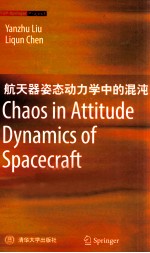图书介绍
航天器姿态动力学中的混沌 英文pdf电子书版本下载

- 刘延柱,陈立群著 著
- 出版社: 北京:清华大学出版社
- ISBN:9787302282983
- 出版时间:2012
- 标注页数:163页
- 文件大小:39MB
- 文件页数:172页
- 主题词:航天器-姿态运动-动力学-混沌理论-英文
PDF下载
下载说明
航天器姿态动力学中的混沌 英文PDF格式电子书版下载
下载的文件为RAR压缩包。需要使用解压软件进行解压得到PDF格式图书。建议使用BT下载工具Free Download Manager进行下载,简称FDM(免费,没有广告,支持多平台)。本站资源全部打包为BT种子。所以需要使用专业的BT下载软件进行下载。如 BitComet qBittorrent uTorrent等BT下载工具。迅雷目前由于本站不是热门资源。不推荐使用!后期资源热门了。安装了迅雷也可以迅雷进行下载!
(文件页数 要大于 标注页数,上中下等多册电子书除外)
注意:本站所有压缩包均有解压码: 点击下载压缩包解压工具
图书目录
Chapter 1 Primer on Spacecraft Dynamics 1
1.1 Orbital Motion of Spacecraft 2
1.1.1 Gravitational Field of a Particle 2
1.1.2 Gravitational Field of a Rigid Body 2
1.1.3 Dynamical Equations of Two-body System 4
1.1.4 First Integrals 5
1.1.5 Characteristics of Keplerian Orbit 8
1.1.6 Elliptic Orbit 10
1.2 Environmental Torques Acting on Spacecraft 12
1.2.1 Gravitational Torque 12
1.2.2 Magnetic Torque 15
1.3 Attitude Motion of Spacecraft in the Gravitational Field 17
1.3.1 Euler's Equations and Poisson's Equations 17
1.3.2 Planar Libration 19
1.3.3 Stability of Relative Equilibrium 22
1.3.4 Attitude Motion of a Gyrostat 26
1.4 Attitude Motion of Torque-free Spacecraft 27
1.4.1 Torque-free Rigid Body 27
1.4.2 Torque-free Gyrostat 29
1.4.3 Influence of Energy Dissipation on Spinning Spacecraft 31
References 32
Chapter 2 A Survey of Chaos Theory 33
2.1 The Overview of Chaos 34
2.1.1 Descriptions of Chaos 34
2.1.2 Geometrical Structures of Chaos 35
2.1.3 Routes to Chaos 37
2.2 Numerical Identification of Chaos 40
2.2.1 Introduction 40
2.2.2 Lyapunov Exponents 40
2.2.3 Power Spectra 42
2.3 Melnikov Theory 44
2.3.1 Introduction 44
2.3.2 Transversal Homoclinic/Heteroclinic Point 44
2.3.3 Analytical Prediction 47
2.3.4 Interruptions 50
2.4 Chaos in Hamiltonian Systems 51
2.4.1 Hamiltonian Systems,Integrability and KAM Theorem 51
2.4.2 Stochastic Layers and Global Chaos 55
2.4.3 Arnol'd Diffusion 58
2.4.4 Higher-Dimensional Version of Melnikov Theory 59
References 61
Chapter 3 Chaos in Planar Attitude Motion of Spacecraft 63
3.1 Rigid Spacecraft in an Elliptic Orbit 64
3.1.1 Introduction 64
3.1.2 Dynamical Model 65
3.1.3 Melnikov Analysis 66
3.1.4 Numerical Simulations 68
3.2 Tethered Satellite Systems 69
3.2.1 Introduction 69
3.2.2 Dynamical Models 70
3.2.3 Melnikov Analysis of the Uncoupled Case 73
3.2.4 Numerical Simulations 74
3.3 Magnetic Rigid Spacecraft in a Circular Orbit 75
3.3.1 Introduction 75
3.3.2 Dynamical Model 77
3.3.3 Melnikov Analysis 79
3.3.4 Numerical Investigations:Undamped Case 80
3.3.5 Numerical Investigations:Damped Case 83
3.4 Magnetic Rigid Spacecraft in an Elliptic Orbit 89
3.4.1 Introduction 89
3.4.2 Dynamical Model 89
3.4.3 Melnikov Analysis 91
3.4.4 Numerical Simulations 92
References 95
Chapter 4 Chaos in Spatial Attitude Motion of Spacecraft 99
4.1 Attitude Morion Described by Serret-Andoyer Variables 100
4.1.1 Serret-Andoyer Variables 100
4.1.2 Torque-free Rigid Body 103
4.1.3 Torque-free Gyrostat 104
4.1.4 Gyrostat in the Gravitational Field 106
4.1.5 Influence of the Geomagnetic Field 107
4.2 Rigid-body Spacecraft in an Elliptic Orbit 108
4.2.1 Introduction 108
4.2.2 Dynamical Model 109
4.2.3 Melnikov Analysis 111
4.2.4 Numerical Simulations 113
4.3 Rigid-body Spacecraft with an Eccentrically Rotating Mass 113
4.3.1 Introduction 113
4.3.2 Dynamical Model 116
4.3.3 Melnikov Analysis 117
4.3.4 Numerical Simulations 119
4.4 Magnetic Gyrostat Spacecraft in a Circular Orbit 120
4.4.1 Introduction 120
4.4.2 Unperturbed Motion of a Gyrostat 122
4.4.3 Melnikov Analysis 123
4.4.4 Numerical Simulations 125
References 127
Chapter 5 Control of Chaotic Attitude Motion 131
5.1 Control of Chaos:An Overview 131
5.1.1 Introduction 131
5.1.2 Problem Formulations 133
5.1.3 OGY Method and Its Generalization 134
5.1.4 Synchronization:Chaos Control in a Broader Sense 136
5.2 The Parametric Open-plus-closed-loop Method 137
5.2.1 Introduction 137
5.2.2 The Control Law 138
5.2.3 Numerical Examples 140
5.2.4 Discussions 144
5.3 The Stability Criterion Method 145
5.3.1 Introduction 145
5.3.2 The Control Law 146
5.3.3 Numerical Examples 147
5.4 Controlling Chaotic Attitude Motions 153
5.4.1 Introduction 153
5.4.2 Dynamical Model of Controlled Spacecraft 154
5.4.3 Applications of the Parametric Open-plus-closed-loop Method 155
5.4.4 Applications of the Stability Criterion Method 156
References 160